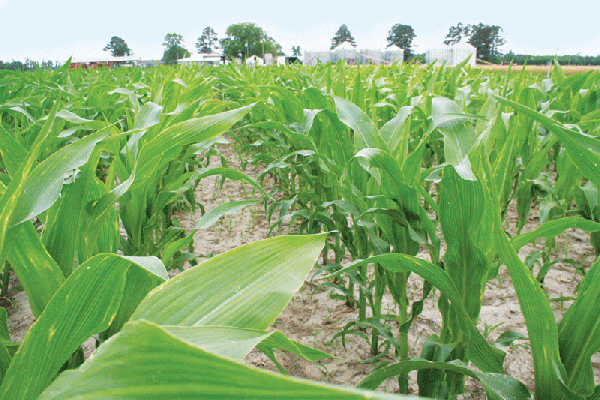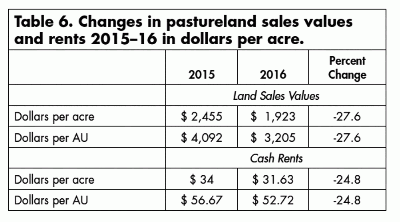
While recent changes in farmland prices nationally have been mostly a factor of location, sale values in the Delta region of Mississippi were mostly flat between 2015 and 2016, according to Bryon Parman, Mississippi State University assistant Extension professor of agricultural economics.

BRYON PARMAN
A survey was conducted in May by the MSU Department of Agricultural Economics and the MSU Extension Service, and included agricultural lenders, appraisers, farm managers, and ag economists.
“Persistently lower commodity prices, sticky input costs, and low farm incomes since 2014 have had a dampening effect on crop farmland values, both nationally and in Mississippi,” Parman says.
“While anecdotal evidence suggests there are pockets within the Mississippi Delta where land values remain strong, other areas are showing a decline. Cropland values outside the Delta of Mississippi remain mostly unchanged from a year ago. Low interest rates and recreational agricultural land income are helping push back against declining farm incomes and land values.
“However, should crop commodity prices stay well below break-even, land values will start moving downward in the Delta and across the rest of the Mississippi.”
But, Parman says, cash rents “require relatively frequent renegotiation and have already begun adjusting to lower crop commodity prices. That is especially true for farmland outside the Delta, where rents have fallen as much as 25 percent. Average cash rents across Mississippi will likely fall even farther into 2017, as the last group of tenants on 3-year leases from the high price period before 2014 will be up for renegotiation.”
For land values, Parman says, “Delta dry land showed a negligible increase of 0.4 percent from 2015 to 2016, while irrigated cropland increased a slight 1.2 percent. The increases are very small, and given the possibility for some sampling error, it’s likely that the average sale prices for non-irrigated and irrigated land haven’t moved much in the last year.”
However, he says, “rents fell substantially” during the period. “Dry cropland rents fell 5.8 percent, and irrigated cropland 7.9 percent.” The change in land rents relative to the change in land values isn’t surprising, he notes, “given that rents are typically negotiated within, at most, 3 years and therefore are much more sensitive to changes in far incomes and profitability.”
Which direction land values heading?
Survey respondents were also asked to give their best guess as to the direction land values and rents would go over the next 12 months, and 62 percent said they expect land prices to go down, with 39 percent expecting no change.
For land rents, 71 percent said they expect a decline in cash rental rates, with 29 percent expecting them to hold fast at the 2016 level.

For land rents, 71 percent of respondents said they expect a decline in cash rental rates, with 29 percent expecting them to hold fast at the 2016 level.
Non-Delta dry cropland sale values for 2016 averaged $2,457 per acre, and irrigated land $3,061 per acre. The maximum sale value for non-irrigated non-Delta farm ground was $3,000 per acre and the minimum was $2,000. The range of sale values for non-irrigated non-Delta cropland was $3,800 per acre, with the lower end being $2,500.
The average cash rent for non-Delta cropland was $79 per acre, with irrigated land averaging $124. The spread between the lowest and highest rental rates was above $100 per acre for both irrigated and non-irrigated farmland outside the Delta.
“Cash rents for non-Delta farmland came down substantially from 2015,” Parman says. “Dry cropland fell almost 25 percent, from $105 per acre to $79, and irrigated cropland fell 14.5 percent from $145 per are to $124. The drop in cash rents for non-Delta cropland was 19 percent greater for dry cropland than for dry cropland in the Delta, while non-Delta irrigated cropland fell 6.6 percent more than its Delta equivalent.”
IT’S FREE! Stay informed on what’s happening in Mid-South agriculture: Subscribe to Delta Farm Press Daily.
When queried about the expected movement in non-Delta cropland values, 61 percent of the survey respondents said they expect no change over the next 12 months for irrigated cropland values, while 39 percent expected a further decline. The expectation for non-Delta dry cropland values was an even 50/50 split between values falling and staying near their 2016 level.
With respect to rents, Parman says, 59 percent of respondents expect non-Delta dry cropland rents to decrease over the next 12 months, while 41 percent look for no change. For non-Delta irrigated land, 33 percent expect a decrease in rents, while 66 percent expect no change.
Outlook for pastureland, timberland
Pastureland values and rents were down sharply from a year ago, according to the survey, reflecting cattle prices adjusting downward from their record highs in 2014 and 2015, he says. “For the most part, grazing land has reverted to the price level and rental rate paid before the cattle price explosion in 2014.
“Heading into next year, while there may still be significant downward movement in pastureland rental rates, it is unlikely that sales values will fall much farther. As far back as 2012/13, grazing land averaged around $2,000 per acre statewide. With a 2016 average value of $1,923 per acre, it is likely that our rangeland has found the bottom. Cash rents for pastureland, however, would still need to come off by approximately $10 per acre to align with the average rate before the beef cattle market spike.”
Check current commodity prices

Pine saw timber prices have mostly failed to approach their most recent highs of $40 per ton, set in the first decade of the 2000s, a Mississippi State University survey shows.
Mississippi pastureland values in 2016 ranged from $1,500 per acre for lower quality land to $2,200 for higher quality acreage. Rental rates averaged $31.36 per acre.
“The largest decline in agricultural land values was in pastureland,” Parman says. “Sale values dropped more than 27 percent from 2015, falling from $2,455 per acre to $1,923. Cash rental rates for pastureland were also off sharply, falling nearly 25 percent.”
In their outlook for pastureland rents, 33.3 percent of survey respondents indicated they expect them to fall over the next 12 months, with 66.6 percent expecting no change. For sale values, 21 percent expect a decrease, and 79 percent no change in dollars per acre values.
For mature pine timberland, the average 2016 sale value was $2,069 per acre, down 10 percent from 2015. The range was between $1,600 and $4,000 per acre, depending on recreational value and overall stand quality.
The sale value for mature hardwood stands averaged $2,470 in 2016, with a range of $1,700 to $4,500 per acre, again depending on recreational value and overall quality of the standing timber.
Important upcoming events: Delta Farm Press Calendar of Events
The sharp decrease in the price for mature pine timberland “comes on the heels of approximately 6 years of pine saw timber prices that stayed mostly below $25 per ton,” Parman says. “Brief spikes have occurred that broke the $25 per ton mark, but pine saw timber prices have mostly failed to approach their most recent highs of $40 per ton, set in the first decade of the 2000s. Until pine prices begin to recover, it’s unlikely mature standing pine timberland will approach $3,000 per acre.”
Mixed-mature hardwood timberland has held steady in the past year, he says. While there was a $5 per ton drop in the latter half of 2015, “those losses have been recovered in 2016, with mixed hardwood saw timber again approaching $40 per ton. If the overall upward trend continues for mixed hardwood prices, it’s possible mixed hardwood land could reach $3,000 per acre in the next 2 years.”
About the Author(s)
You May Also Like




